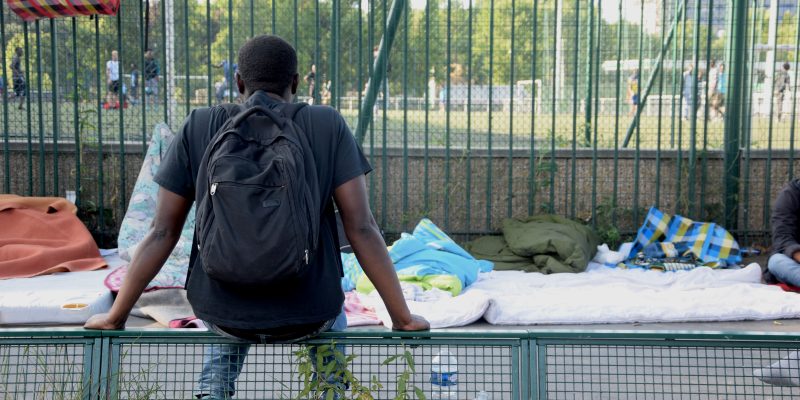From the Jungle to Porte de la Chapelle
Every morning at 7, Tabib, 25 and baby-faced, stands in line and waits. Together with his friends who are also from Sudan, he leaves the makeshift bed he has built on Boulevard Ney, crosses the four-lane road from Porte de la Chapelle to the highway and hopes that today will be the day. “They’ve got to open that gate sooner or later,” he says, just as he has said every day for two months. “Sometimes people manage to get in, so we try every day. So far, we’ve always been pushed back by the police. They use tear gas and hydrants, but we’re not giving up.” This daily ordeal is shared by Tabib with hundreds of other people camped out in the corners of this neighbourhood north of Paris where Mayor Anne Hidalgo has established the humanitarian camp, or bulle, as a first reception facility for migrants and asylum seekers. A giant white and yellow dome that can house up to 400 people, it has been overflowing for months. Getting in has become a kind of lottery, and this is why a makeshift camp made of tents, mattresses, and cardboard boxes has formed around Porte de la Chapelle.
Tabib sits on the ground with his shoulders against the fence surrounding the soccer field where a few children are playing. He tells me that before arriving here he lived for six months in Calais, hoping one day to find passage to the UK. But all of his attempts to cross the Channel were unsuccessful, and so, after the evacuation of the so-called Jungle, he came to Paris. He has been living on the streets for about a year. “First I was in a squat, then I came here because I’d heard that there was this humanitarian centre. But I didn’t think it’d be so difficult, that I’d be worse off than I had been in the Jungle.” Like many other Sudanese, he went through Italy after spending some time in Libya. Once he arrived in Sicily, he travelled the peninsula and then had to wait in Ventimiglia for weeks before he managed to cross the border. In the Roja Valley, he says, he was helped by Cédric Herrou, and the memory of the French farmer is the only one that brings a smile to his lips. “Where are the lawyers, where are the legal experts who ought to be doing something for these people? What’s happening here is a disgrace,” Hasna, an activist who is well known for her work on behalf of migrants and refugees, interrupts us. A black keffiyeh on her head and a determined look in her eyes, she says “France’s commitment to protecting human rights is shattered right here on these sidewalks. There is no dignity here; these people are living in filth. Where is the equality and fraternity?”
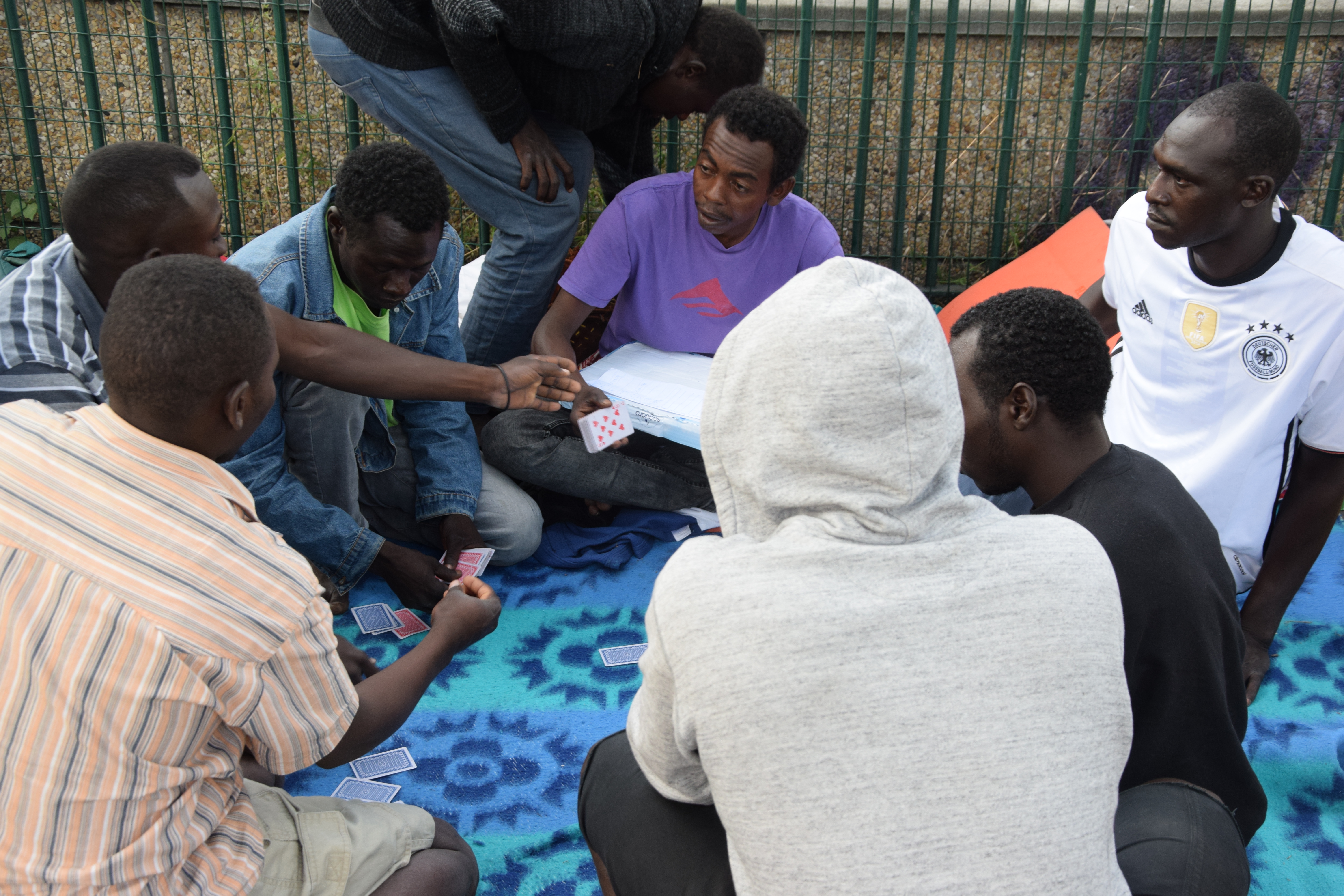
Migrants playing cards at the makeshift camp in Porte de la Chapelle, waiting for the final hour of fasting during Ramadan (image: Veronica Di Benedetto Montaccini)
The number of people camping out on the boulevards of Porte de la Chapelle varies from week to week: 300-400 on a typical day, but it can skyrocket to 1000 on crowded ones. They are all men between 17 and 30, and they come from Sudan, Afghanistan, Eritrea, and Syria. Families with children, as well as unaccompanied minors, are the only ones that get immediate access to the bulle. Over the last few months, the area outside has been evacuated several times with the last major raid in May. Every time, however, the makeshift camp is resurrected. Under one of the highways, the administration has placed boulders to stop new tents from being pitched. A group of artists calling themselves ‘Coeurs de pierres et solidaires’ decided to turn it into an art installation via a Facebook post, calling all citizens to help carve the founding words of the French Republic liberté, égalité et fraternité into the rocks. One of the inscriptions was dedicated to all those who have lost their lives in the attempt to cross the border: en mémoire de ceux qui ne sont pas arrives (in memory of those who did not make it).
The weather is hot, and no one can enter the bulle
During the days of canicule, the air is unbreathable, and the smell of rubbish blends in with the fumes from the passing cars. When it rains, the pools stagnate for days. The camp has very poor sanitary conditions: there are no showers or portable toilets; migrants use the one fountain near the soccer field to wash themselves, and they go to the toilet in the outdoors. The streets are not always cleaned, which is why, on the evening of June 25th, right below the huge “Paris en mode” sign advertising the city’s bid for the 2024 Summer Olympics, the migrants threw the rest of their food onto the ground in protest. The police intervened, followed by the sanitation services. But the situation is getting worse every day. A group of NGOs, including Jrs, Caritas France and Cispm issued a joint plea: “The administrative abuse within the centre, as well as the physical abuse suffered by those who try to access it daily while forced to sleep in the streets, is not the by-product of an influx of refugees that France – the world’s sixth power – was unable to manage. It is the consequence of the structural inadequacy of the migrant reception system, and part of a strategy of deterrence that France, and Europe in general, is adopting against people in need of protection.” The associations have also called for the opening of more first reception facilities in Paris as well as in Calais and Ventimiglia.
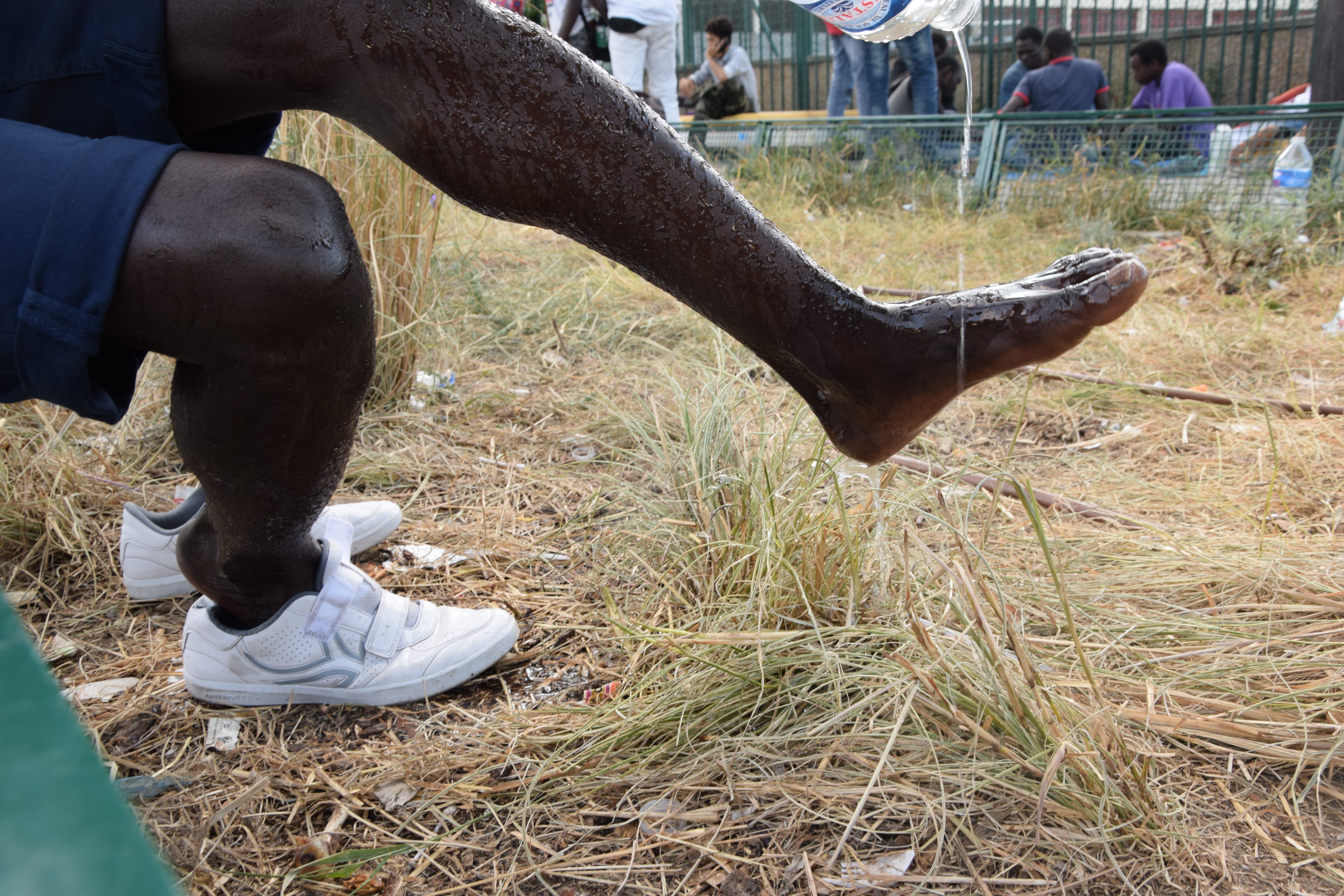
A young migrant washes himself with a bottle of water from the fountain at the makeshift camp in Porte de la Chapelle (image: Veronica Di Benedetto Montaccini)
Meanwhile, everybody says it’s impossible to enter the bulle, but that doesn’t stop people from trying. The most determined group is the Afghans, the second most numerous after the Sudanese. Some of them are now sleeping in front of the crush barriers set up by the police to keep migrants away. K.K., who is 22 years old, has pitched his small tent a short distance from the police post and a German shepherd that keeps barking even with a muzzle. “I arrived here about two months ago,” he tells me, “after living in Germany for two years. I applied for asylum there, but I was rejected because they consider Afghanistan a safe country. I’d like to try in France now, but I think it’s going to be just as hard.” He took the Balkan route to Germany, crossing Bulgaria, Serbia, Slovenia, and Austria. “I thought everything would turn out well, but now I have to start all over again, and I could still end up deported back to my country.”
Omar, on the other hand, has been granted asylum after three years, but even he is living on the streets with the other migrants at Chapelle. “The humanitarian centre keeps saying they don’t have enough room for everyone; I think they are taking nationality into account. We Sudanese are not considered,” he says. Smarter than the rest, since he has lived here Omar has been amusing himself interviewing everyone who comes to monitor the situation, including the reporters. The first question he asks is whether the other person has a home and a roof to sleep under; then he asks whether they would be willing to help a refugee if they found one on their doorstep. He has kept all the interviews, hoping to make something out of them one day. “I do it with everyone,” he explains, “even with the policemen when they drive us off with spray and hydrants. Very often they don’t know how to answer, I think even they know that what they are doing is deeply unjust.” The association Gisti (Groupe d’information et de soutien des immigrés) filmed one of these police actions where migrants were dispersed using tear gas. “This humanitarian camp, opened in November 2016 following an initiative by the mayor of Paris and managed by Emmaus, has been proposed as a window into the reception effort, but it conceals a different reality,” the association wrote in a post. “After months in Porte de la Chapelle, the welcome committee for the exiles fleeing Afghanistan, Syria, Sudan, and Eritrea was made up by gendarmes. Some were armed, some had spray bottles in their hands, and all were positioned behind protective barriers. Why is this happening? Because the camp is overflowing and the government is unwilling to open more reception spaces.” Entering the humanitarian camp is difficult even for reporters: our request for access was denied. The communication office of the association Emmaus, which runs the camp, has informed me “there are too many requests from the media” at the moment and that it is their duty “to preserve the work of operators in the camp.”
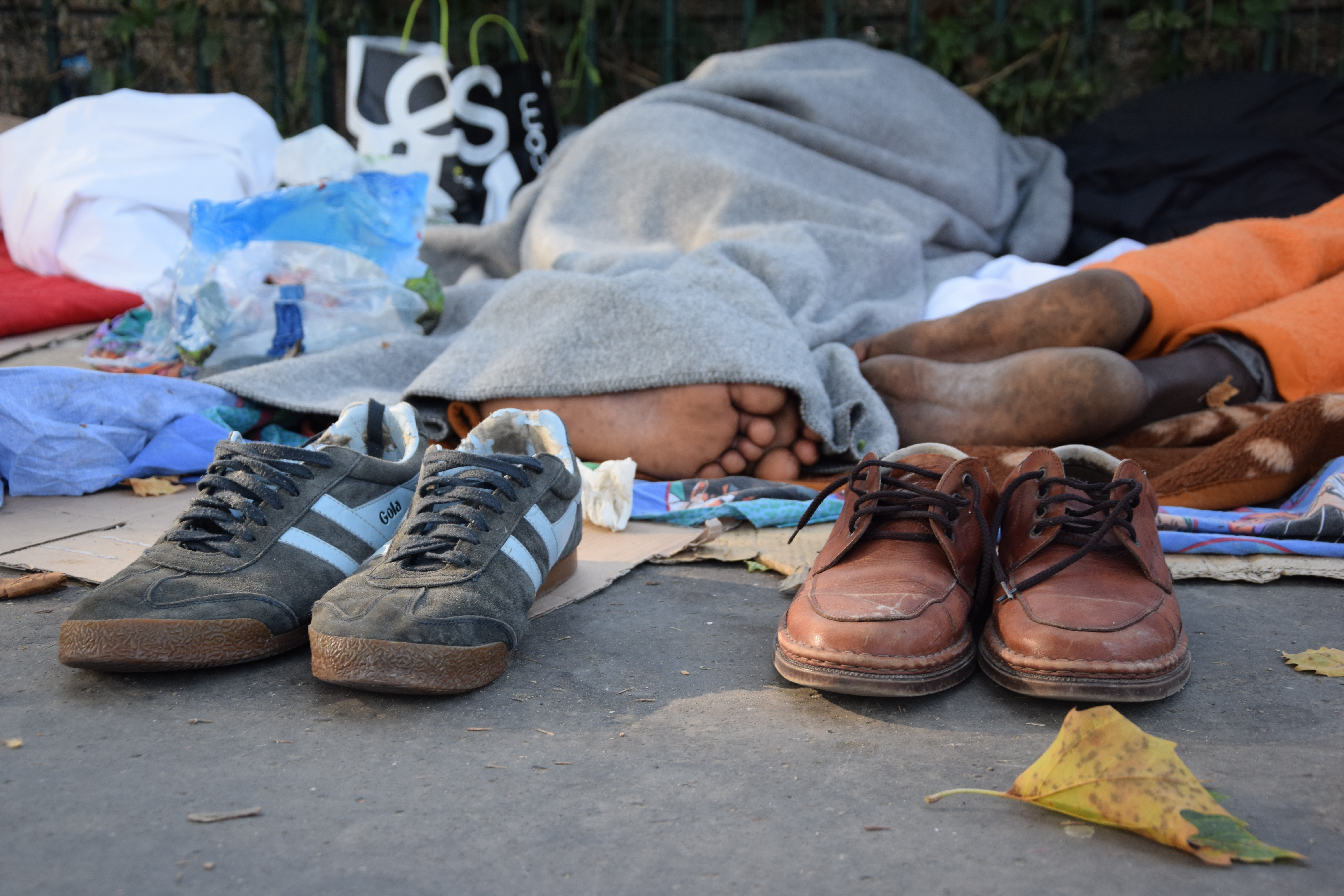
The shoes of two migrants at the makeshift camp in Porte de la Chapelle (image: Veronica Di Benedetto Montaccini)
At the entrance I am greeted by Yann Manzi of Utopia 56, the association collaborating with Emmaus in the management of the bulle. He says they are all well aware of what is out there, but there is nothing they can do if the centre is overflowing. France should think about opening new centres because immigration statistics here are nothing like Italy’s. According to the latest Eurostat report on the first quarter of 2017, the highest number of asylum claims in Europe was recorded in Germany (with more than 49,000 applications, equal to 30 per cent of all the applications received by EU member states), followed by Italy with 36,900 applications (22 per cent of the total), and France with 22,000 applications (13 per cent of the total). With 14,600 more asylum seekers (+66 per cent), Italy has seen the highest increase from the first quarter of 2016, while France (contrary to the trend in other northern countries where the number of applications has been decreasing) has remained relatively stable with a +19 per cent increase. As for the reception statistics, France has about 17,000 people housed in the CAOs (Centres for Extraordinary Reception) and a projected 13,500 people in the CADAs (Reception Centres for Asylum Seekers). The city of Paris alone has received about 8,000 people in the first reception centre at Porte de la Chapelle over the last four months.
Volunteers are the only ones helping the migrants
Salah, who is from Darfur, explains to me that reception is an issue throughout France. “I live in the centre now, but for a long time I used to live on the streets, too, in the Jardins d’Eole, north of Paris.” As we walk, he tells me that he was a student in his country and that he made a living by transporting goods for private individuals. “I had many problems because I am a Zaghawa, and the government of my country thought that I was with the rebels. So I was forced to leave. I escaped to Libya, and I stayed there for two and a half years. It was really tough, I was stigmatized, just like every other dark-skinned person. But I found a job, I made hay for the pastures. Then the situation in the country exploded: there was no longer a government and staying became impossible, it was chaos, it was just too dangerous. Some of my friends were locked in detention centres, others were kidnapped. It was too dangerous, so I took a boat to Italy.” Salah explains how, for a time, he lived in a reception centre in Rovigo. “I have to say it was good, we were treated with dignity. But I didn’t want to stay in Italy, so I went to Ventimiglia, crossed the border and arrived here. I had many problems, but now I’m waiting for my asylum interview. I hope this will be my lucky time.” We are interrupted by the sound of a horn honking: a man, Salim, pulls up in a station wagon, and a long line of cars forms along the wall, where somebody wrote: Where is my dignity? It’s dinnertime. The volunteer group Oumma has prepared five hundred meals: every ration contains rice, chicken, dates, and a water bottle. The group is made up mostly of Muslims, but there are also some Catholics: they prepare the meals with the ingredients obtained through private donations. “We all cook together for these people who need help.”
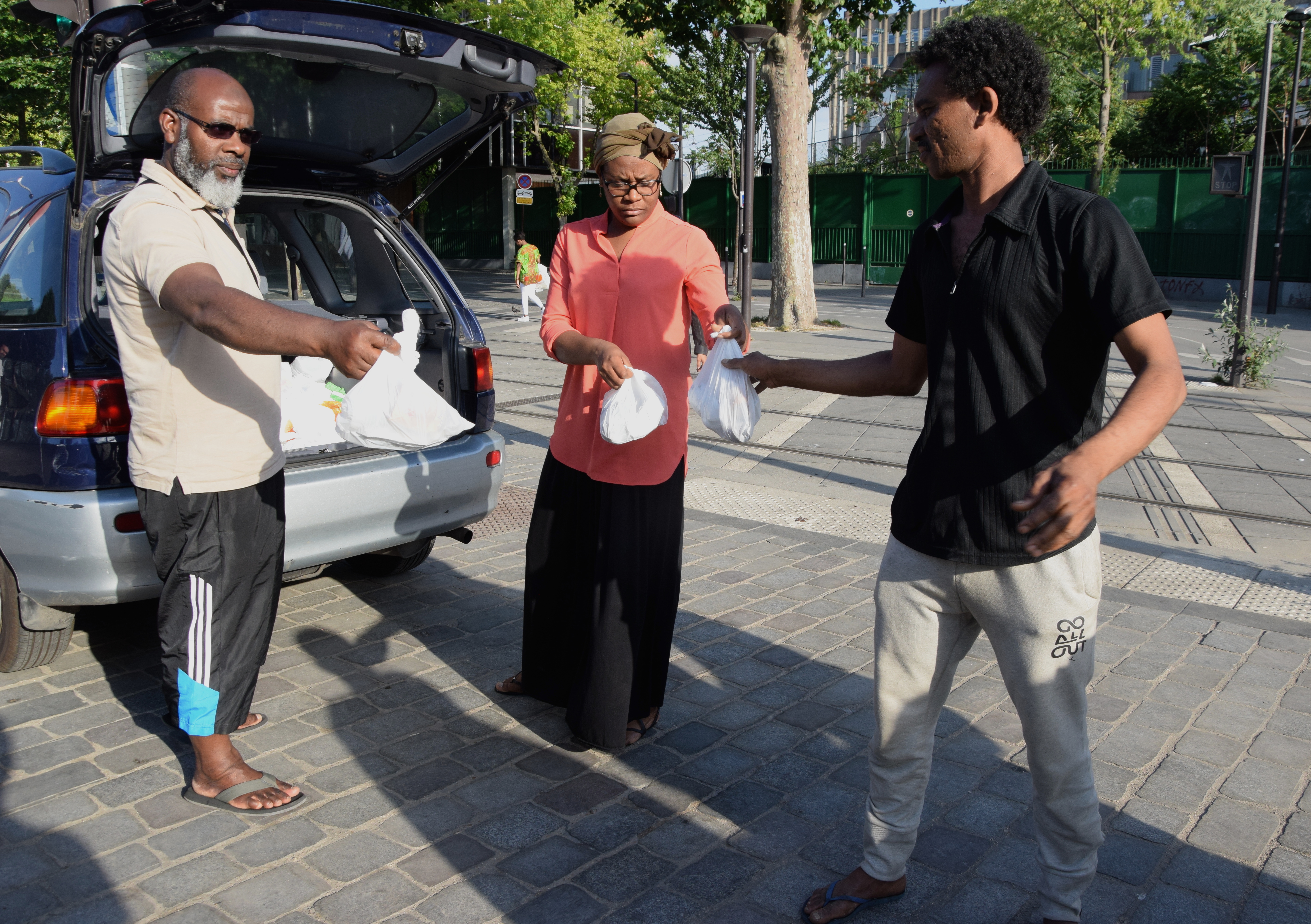
Volunteers distributing food rations at the makeshift camp in Porte de la Chapelle (image: Veronica Di Benedetto Montaccini)
Several volunteer networks, both private individuals and associations, are helping the migrants camped out at Porte de la Chapelle. They come here despite Interior Minister Gérard Collomb’s announcement of a crackdown. “It is scandalous that everything hinges on the work of volunteers,” says Maurizia Balmelli, a Swiss translator who has been living in Paris for years and is a member of Baam, an association founded in 2015 to support migrants through language courses, legal protection, and other forms of assistance. “Very often the volunteers have no guidance; everything happens randomly,” she adds, “the state does what it wants in the name of certain laws, such as the Dublin Regulation.” Billel, from the association Un monde sans faim, also says that what is happening here is “a disgrace, people cannot live in these conditions. We’re helping them in any way we can, but it’s the state that should provide them with housing.” “All of this breaks my heart,” echoes Hamine, a woman of Algerian origin who lives in the neighbourhood, and occasionally comes by to donate something. “Many of the residents are complaining about this situation,” she says, “some fear that the migrants will stay here forever, but others are helping them.” In the green area that divides the two central avenues, a woman is distributing bread and cookies together with her husband and their two children.
A short distance away, Mousavi, who is from Afghanistan, walks out of the bulle holding a box full of food. He is wearing a Trieste basketball team t-shirt. He tells me he got it from an Italian volunteer named Ilaria back when he was living in the Belgrade train station. “Now I live in a hotel on Boulevard Schuman together with my wife and our four children,” he says with pride, showing me a picture of his family taken at the station. “We only come here to get some food. We are possibly among the few who can say that they made it.”
Update: after the publication of this article, the makeshift camps of Porte de la Chapelle have been evacuated by the police.
Translation by Francesco Graziosi. Proofreading by Alexander Booth.
Cover: the gates of the soccer field next to the makeshift camp in Porte de la Chapelle, north of Paris, where migrants have been hanging their possessions (all images in this article by Veronica Di Benedetto Montaccini).




